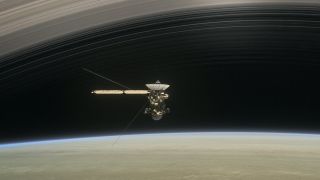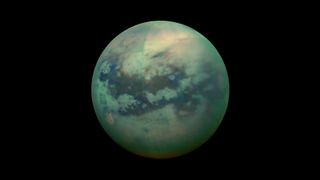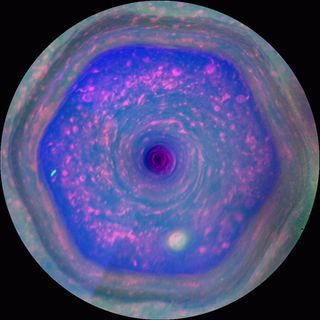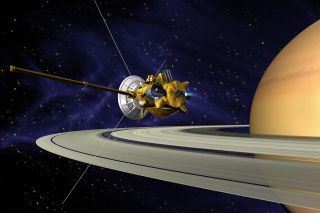Cassini's 13 Greatest Discoveries During Its 13 Years at Saturn
Cassini's Great Discoveries

The Cassini spacecraft spent more than a decade in the Saturn system, and what a mission it has been. Cassini revealed new information about the potential habitability of icy moons; it uncovered features that look like pop-culture symbols; and it delivered a glimpse below the atmosphere of Titan, in part by successfully landing a probe on the orange moon's surface.
Among years of observations, it's hard to single out Cassini's best discoveries at Saturn (and the probe also had that stunning Jupiter flyby in 2000), but we've done our best and picked out 15 notable things that Cassini revealed about Saturn. You can see more details in the slideshow.
Making icy moons look more habitable than ever

Cassini was the first mission to spend an extended period of time in Saturn's neighborhood. (The Voyager probes and the Pioneer 11 probe had all made short flybys of Saturn prior to Cassini's arrival.) In doing so, Cassini revealed new levels of complexity in Saturn's moons. The probe found evidence of subsurface oceans of liquid water on some of the moons, spotted geysers and other geologic activity, and even found indications of prebiotic chemistry (more on that further on in the countdown).
Based on Cassini's findings, scientists think the Saturn system is home to multiple moons that could be hospitable to life. The science revealed by Cassini will also help scientists search for life in other solar systems, because the researchers can extend the lessons of this mission to planets orbiting other stars.
Landing on Titan (and studying the moon's prebiotic chemistry from orbit)

The Huygens lander made it all the way down to the surface of Titan on Jan. 14, 2005, which was exciting for scientists in a few ways. First, researchers knew almost nothing about Titan's surface at the time; pictures of Titan from both Voyager spacecraft showed a blurry orange haze shrouding whatever was below. Huygens got beneath that haze and found a moon with a solid surface dotted with lakes, oceans and rivers made of hydrocarbons (mostly methane and ethane). Huygens also gave scientists a lot of information about Titan's environment, from the winds in the upper atmosphere to the dunes on the surface that form from a strange material.
Huygens died within hours of landing (it was only designed to last a short while), but Cassini's observations of Titan continued with many close flybys. Perhaps its greatest discovery was finding evidence of prebiotic chemistry on Titan — meaning chemistry that could, in theory, give rise to life. Among many other discoveries, Cassini tracked the seasonal changes in Titan's hydrocarbon lakes and seas, and also watched the appearance and disappearance of mysterious "islands" in one of those lakes, which scientists now think could be streams of bubbles.
The jets and ocean of Enceladus

The plumes of liquid water spewing into space through cracks in the icy surface of Saturn's moon Enceladus are another highlight of Cassini's productive mission. The spacecraft found at least 101 sites where geysers erupt. These eruption sites tend to be in the "tiger stripes" (cracks) on the surface of the icy moon.
The spacecraft provided scientists with strong evidence that Enceladus possesses a worldwide liquid-water ocean underneath a shell of ice 19 to 25 miles (30 to 40 kilometers) thick, and this is very likely the source of the liquid in the plumes.
Just a few months ago, Cassini discovered that there is hydrogen in these plumes, which is a hint that there could be hydrothermal vents in the ocean, creating a warm, friendly place for life to congregate, similar to the undersea vents in Earth's oceans.
The many flybys of Enceladus produced other remarkable finds. Notable ones include evidence of plate tectonics around the south pole (since the terrain keeps changing).
Watching Saturn's rings evolve

While the rings of Saturn look static in a small telescope, up close they are a constantly changing sea of particles and small rocks. The F ring (one of the outermost rings) in particular changes quickly — features observed in the F ring by the Voyager probes in 1980 and 1981 had disappeared by the time Cassini began studying the system in 2004. The F ring is one of the most active rings ever observed.
Cassini observed evidence of collisions in Saturn's rings from meteoroids, or small bodies that originate somewhere out of Saturn's system. A study of those collisions, published in the journal Science in 2013, implied that Earth and Saturn both have the same rate of meteoroid impacts, despite being far apart in the solar system.
A set of stunning pictures released in 2013 shows the ripple effects of these small bodies crashing into the rings. The scientists could even make models to show when the meteoroid strikes occurred, including a 12,000-mile (19,000-km) ripple that the researchers dated back a generation, to 1983.
In April 2017, Cassini began a series of maneuvers that allowed it to zoom in between Saturn and the planet's innermost rings, allowing the probe to get a close look at some of the rings' vertical structures and propellers (disturbances in the rings). While the science is still pouring in from those observations, the data will surely yield information about how the rings change over time.
The hexagon storm

Scientists are fascinated with the changes in storms and features in the giant planets of our solar system. Jupiter's Great Red Spot, for example, may have existed for at least 400 years. But the storm has also been shrinking for decades, and nobody knows why. Neptune also had storms pop in and out of existence after the Voyager 2 flyby there in 1989.
At Saturn, Cassini examined a hexagonal-shaped jet stream (better known as "the hexagon") at the planet's north pole, with a swirling vortex at its center. Evidence of the storm first appeared in data gathered by the Voyager probes in 1980 and 1981, but Cassini's observations confirmed its existence. The probe also saw two huge storms at both poles that resemble hurricanes. Cassini probed the composition of the north pole vortex and studied the winds associated with it. Based on the Cassini observations, scientists suggest that perhaps the hexagonal pattern persists in Saturn's cloud tops because there is a shallow jet stream in the region supported by winds that are not very far underneath.
Figuring out why Iapetus looks so weird

Iapetus' two-toned appearance puzzled scientists for a long time. One side of the moon is dark and the other is light; this false-color image shows the extent of the contrast. And there appears to be no "gray" on Iapetus — meaning no mixture of the light and dark material. By 2007, early observations of the moon suggested that the difference was because of sunlight and dust. That theory evolved further in 2009, when scientists identified a ring of material trailing the nearby moon Phoebe.
In brief, the theory suggests that Iapetus is flying through Phoebe's ring of debris (the F ring), and because it is tidally locked, one side always faces the incoming debris and gets covered. These dark particles absorb more sunlight than the brighter, default surface of Iapetus. As sunlight strikes the dark regions, it melts away the ice. Then water vapor from the melting region goes to the nearest cold area, freezing on the brighter spots and amplifying their brightness.
Discovering multiple moons

Excluding Saturn's ice- and rock-filled rings, the planet hosts 53 known moons and eight provisional (unconfirmed) moons, according to NASA. The mind-blowing thing is that when the mission began in 1997, scientists only knew of 18 moons around Saturn. Even while Cassini was en route, Earth-based telescopes discovered 13 more.
Earth-based observations as well as those from Cassini have helped uncover even more moons since the mission began. Shortly after arriving in July 2004, the spacecraft uncovered the tiny moons of Methone and Pallene, followed up by discoveries of moons such as Polydeuces, Daphnis and Aegaeon.
Learning more about Saturn's rotation rate

Thanks to Cassini, scientists know a lot about Saturn, but one of the planet's basic characteristics still eludes us — how long is a day there? On a rocky planet like Earth, the rate of the planet's spin can be measured by watching a point on its surface. But for gas planets like Saturn, a day is determined by the rotation of the planet's core, which may not always align with the motion of the clouds and gases that surround the core. Current estimates suggest Saturn's day is about 10.2 hours.
At Jupiter, scientists have detected radio waves that are naturally created by the planet's spinning core. Researchers can use those waves to figure out how long that planet's day is. But Cassini found that a similar radio signal from Saturn — called the Saturn Kilometric Radiation — is different in the northern and southern hemispheres. More weirdly, the radio-wave patterns change with the seasons— making it very difficult to figure out what's going on inside Saturn.
"Pac-Man" on Tethys and Mimas

It seems like scientists love using pop culture to make the moons of Saturn come alive in the public's eye. Perhaps the most notable example is the nickname they gave Mimas: They call it a Death Star because its huge crater, Herschel, gives it the appearance of the infamous "Star Wars" weapon.
And in another striking example of this trend, it turns out that Mimas and Tethys both have features that look like another 1980s pop-culture video game hit: "Pac-Man."
The V shape of Pac-Man's gaping mouth, cut out of a featureless, circular head, shows up in a heat signature detected on both moons. The two satellites are tidally locked, meaning one side always faces Saturn. Scientists theorize that the shape occurs because high-speed electrons smash into the leading side of each moon's surface, transforming the soft terrain into hard-packed ice, which is more reluctant to cool down at night — or to heat up during the day — than "fluffier" terrain, according to NASA. The cooler regions seen in the infrared images are the hard-packed ice; the rest of the terrain warms up faster in the daytime, to create the Pac-Man silhouette.
Finding an ingredient of plastic

In 2013, scientists discovered an essential ingredient of plastic, called polypropylene, in the atmosphere of Titan. On Earth, it is used everywhere from car bumpers to plastic containers. It can appear organically in nature, but humans typically produce it artificially from sources such as oil refining.
Polypropylene is a hydrocarbon, and consists of three carbon atoms and six hydrogen atoms. The Voyager probes did not detect polypropylene in Titan's atmosphere, but they did detect molecules from the same chemical family — those that contained three carbon atoms, but with four hydrogen atoms and eight hydrogen atoms, respectively. Researchers were puzzled that the middle member of the family seemed to be absent.
"This measurement was very difficult to make because propylene's weak signature is crowded by related chemicals with much stronger signals," Michael Flasar, Goddard scientist and principal investigator for the Composite Infrared Spectrometer (CIRS) instrument that was used for the observations, said in a statement at the time. "This success boosts our confidence that we will find still more chemicals long hidden in Titan's atmosphere," Flaser said.
Life as we know it could not survive on Titan's chilly surface (it's too cold for liquid water), but it is a fascinating destination: It looks similar to rocky planets like Earth, but it has a totally different base chemistry. Its lakes and rivers are made of methane and ethane, and the wind-swept dunes on its surface are made from hydrocarbon grains (unlike sand grains on Earth, which are silicates). Researchers are interested to find out if Titan could have the ingredients to create a variation on life as we know it.
Join our Space Forums to keep talking space on the latest missions, night sky and more! And if you have a news tip, correction or comment, let us know at: community@space.com.
Get the Space.com Newsletter
Breaking space news, the latest updates on rocket launches, skywatching events and more!

Elizabeth Howell (she/her), Ph.D., is a staff writer in the spaceflight channel since 2022 covering diversity, education and gaming as well. She was contributing writer for Space.com for 10 years before joining full-time. Elizabeth's reporting includes multiple exclusives with the White House and Office of the Vice-President of the United States, an exclusive conversation with aspiring space tourist (and NSYNC bassist) Lance Bass, speaking several times with the International Space Station, witnessing five human spaceflight launches on two continents, flying parabolic, working inside a spacesuit, and participating in a simulated Mars mission. Her latest book, "Why Am I Taller?", is co-written with astronaut Dave Williams. Elizabeth holds a Ph.D. and M.Sc. in Space Studies from the University of North Dakota, a Bachelor of Journalism from Canada's Carleton University and a Bachelor of History from Canada's Athabasca University. Elizabeth is also a post-secondary instructor in communications and science at several institutions since 2015; her experience includes developing and teaching an astronomy course at Canada's Algonquin College (with Indigenous content as well) to more than 1,000 students since 2020. Elizabeth first got interested in space after watching the movie Apollo 13 in 1996, and still wants to be an astronaut someday. Mastodon: https://qoto.org/@howellspace
